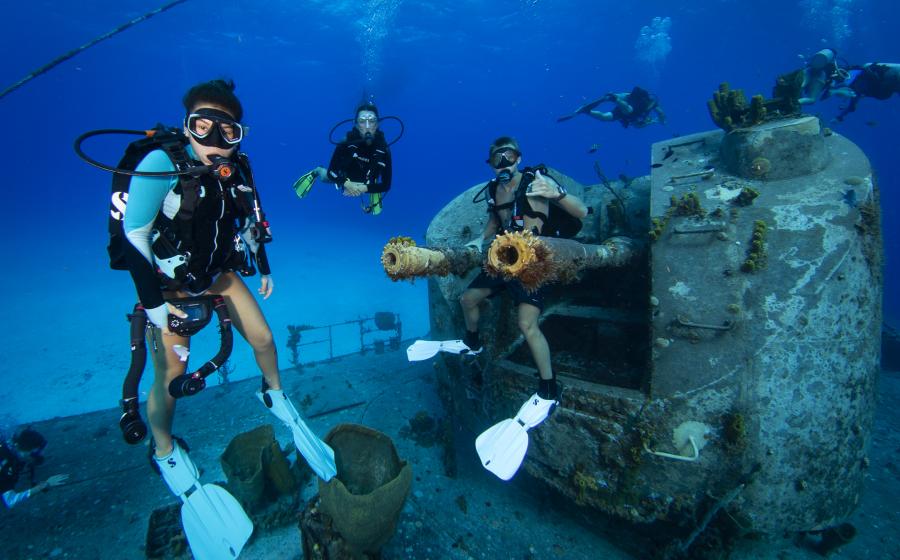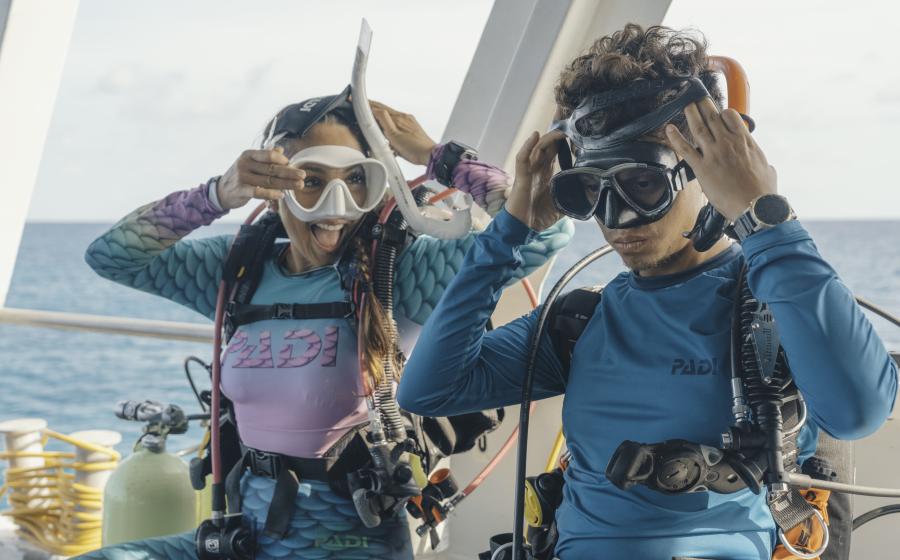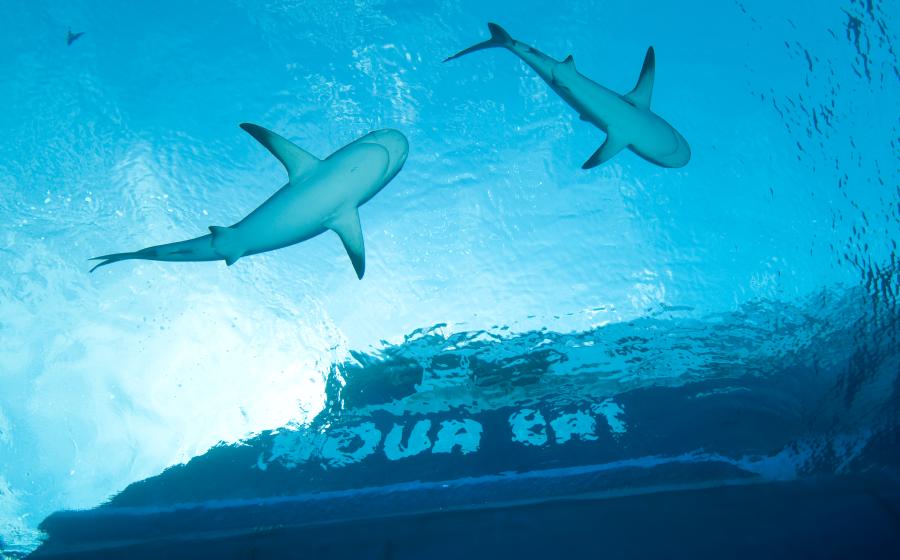Shape Up to Go Down
 |
| Get on the ball for powerful finning and painless gear-hauling. |
June 2003
By Selene Yeager
Photography by Beth Bischoff
Let's be honest--reef diving in Key Largo isn't exactly like lacing up for the Boston Marathon. And sure, we all know divers whose idea of exercise is a rum runner. But even if our underwater adventures tend to be more restful than aerobic, diving can be surprisingly strenuous. And when the sport turns tough, trouble happens. Dive accident research shows that poor fitness is the underlying factor behind many injuries and fatalities.
"Scuba requires more strength, balance and agility than most people realize," says frequent diver Mary Ann Everhart-McDonald, MD. "The tanks are heavy and cumbersome, especially as you're carrying them to the boat and trying to pull yourself from the water and up a skinny ladder."
What's more, the waters aren't always calm and clear. Finning against strong current can put even a seasoned diver's strength to the test. But there's no reason you can't be in better shape by the time you leave for your next dive trip, says Louanne Perfetti, owner of Fitness Tactics in Vail, Colo. "Just a few weeks of strength training can give you tremendous gains in strength--and confidence--for your next dive."
Fit for a Dive
Most importantly, you should have a decent level of aerobic fitness before you take your plunge. At a minimum, that means you should be able to do 10 to 20 minutes of moderate exercise, like pedaling a bike or swimming laps, without the panting that can over-breathe your regulator. "You can build a solid fitness base by doing some aerobic activity for about 30 minutes most days of the week," says Perfetti.
You also need strength to heft heavy equipment without hurting yourself and to hold your own against choppy waters. The following exercises target your scuba muscles, especially the legs and "core" (back, abs and hips). Perform two sets of 12 to 15 repetitions of each exercise. For the best results, do the routine 2 to 3 times a week. You'll feel the difference in just 3 or 4 weeks.
Note: Don't worry about performing your full routine on a multi-day dive trip. But definitely perform the scuba-specific stretches every day to keep your muscles loose for the next dive.
1. Ball Push-Ups
||
|---|
|

|
Lie facedown on an inflated exercise ball with both hands on the floor. Walk your hands out, allowing the ball to roll beneath your body until the ball is under your shins. Your hands should be directly below your shoulders, so it looks like you're ready to do a push-up. Keeping your torso straight and abs contracted, bend your elbows and lower your chest toward the floor. Stop when your upper arms are parallel to the floor. Pause, and return to start.
DIVE BENEFIT: Strengthens upper body and core muscles for longer diving with less fatigue.
2. Wall Squats
Holding a dumbbell in each hand, stand with an inflated exercise ball between your back and the wall. Your feet should be slightly out in front of your body. Keeping your torso erect, and eyes facing forward, bend your knees and squat down, rolling along the ball toward the floor until your thighs are parallel to the floor. Hold that position for 5 seconds; then return to start.
DIVE BENEFIT: Strengthens legs for lifting gear and climbing ladders.
3. Bridges
Lie on your back with your arms at your sides, and heels resting on an exercise ball. Contract your glutes and lift your butt off the floor. Bend your knees and roll the ball slightly toward you until the soles of your feet are flat on the ball. Reverse the move to the starting position.
DIVE BENEFIT: Hip strength for swimming and finning.
4. Step Ups
Stand in front of a 12- to 18-inch stable box or bench with legs shoulder-width apart, knees slightly bent, upper body straight, and holding dumbbells down by your sides. Step up on the box with right foot, followed by the left foot. Step down and repeat starting with the left foot.
DIVE BENEFIT: Climbing from the water to the boat while carrying a load.
5. Calf Raise
Stand facing a wall with an exercise ball supported between your belly and the wall. Keeping your torso straight (don't lean into the ball), raise yourself up onto your toes. Pause, then lower yourself. Hold dumbbells to make the move more challenging.
DIVE BENEFIT: Finning power.
6. Back Flies
Drape yourself face-down on an exercise ball with your torso against the ball and your knees and feet on the floor. Grasp a pair of dumbbells. Extend your arms, keeping your elbows slightly bent, so the weights are a few inches off the floor. Squeeze your shoulder blades together and raise the weights up to chest level. Pause, then lower back to the starting position.
DIVE BENEFIT: Put on your BC and tank without that nagging pain between your shoulder blades.
Be a Flexible Finner
Strength and flexibility go hand-in-hand for healthy, pain-free diving, says Mary Ann Everhart-McDonald, MD. Here are the essential stretches she recommends for divers. You can do these exercises every day, but they're especially good for multiday trips when your muscles are working overtime. Hold each stretch for about half a minute.
The Cat: Kneel on your hands and knees with your head, neck and back in alignment. Keeping your shoulders relaxed, lower your chin toward your chest, pull in your belly, and round your back, like a cat arching. Hold for 30 seconds, then slowly return to the starting position, with your neck and back aligned.
Lying Leg Pull: Lie on your back with your legs bent and both feet on the floor. Straighten and raise your left leg. Gently pull your thigh toward your body and hold. If you can't reach your leg, loop a towel under your foot and, with a slight bend at the knee, gently pull your leg toward your chest. Hold for 30 seconds, then return to start. Repeat with the right leg.
The Bed Stretch: Sit on the edge of your bed, with your right leg extended straight out and parallel to the edge of the mattress. Allow the other leg to dangle off the edge of the bed. Keep your back straight and bend forward from your hips. Hold for 30 seconds, then return to start. Repeat with the left leg.
Avoid an Aching Back
||
|---|
|

|
Strengthening your abs and your lower back muscles can prevent pains that could ruin your dive. The following two exercises can help.
Back Extension: Lie face-down with an exercise ball under your lower torso. Position your feet wide apart for balance. Clasp your hands behind your head and drape your torso over the ball. Contract your abs, and slowly lift your chest off the ball, bringing your shoulders up until your body is in a straight line. Pause, then slowly lower.
Ab Crunch: Sit on an exercise ball with your feet shoulder-width apart on the floor. Lean back, allowing the ball to roll beneath you. With your hands behind your head, contract your abdominal muscles so that your shoulders come up and forward a few inches. Pause, then slowly return to the starting position.
Go to The Ball
An inflated exercise ball is one of the best pieces of fitness equipment you can buy. It strengthens your muscles while also improving your balance and agility. Available in most major sporting goods stores, balls cost around $30.

| | Get on the ball for powerful finning and painless gear-hauling.|
June 2003
By Selene Yeager
Photography by Beth Bischoff
Let's be honest--reef diving in Key Largo isn't exactly like lacing up for the Boston Marathon. And sure, we all know divers whose idea of exercise is a rum runner. But even if our underwater adventures tend to be more restful than aerobic, diving can be surprisingly strenuous. And when the sport turns tough, trouble happens. Dive accident research shows that poor fitness is the underlying factor behind many injuries and fatalities.
"Scuba requires more strength, balance and agility than most people realize," says frequent diver Mary Ann Everhart-McDonald, MD. "The tanks are heavy and cumbersome, especially as you're carrying them to the boat and trying to pull yourself from the water and up a skinny ladder."
What's more, the waters aren't always calm and clear. Finning against strong current can put even a seasoned diver's strength to the test. But there's no reason you can't be in better shape by the time you leave for your next dive trip, says Louanne Perfetti, owner of Fitness Tactics in Vail, Colo. "Just a few weeks of strength training can give you tremendous gains in strength--and confidence--for your next dive."
Fit for a Dive
Most importantly, you should have a decent level of aerobic fitness before you take your plunge. At a minimum, that means you should be able to do 10 to 20 minutes of moderate exercise, like pedaling a bike or swimming laps, without the panting that can over-breathe your regulator. "You can build a solid fitness base by doing some aerobic activity for about 30 minutes most days of the week," says Perfetti.
You also need strength to heft heavy equipment without hurting yourself and to hold your own against choppy waters. The following exercises target your scuba muscles, especially the legs and "core" (back, abs and hips). Perform two sets of 12 to 15 repetitions of each exercise. For the best results, do the routine 2 to 3 times a week. You'll feel the difference in just 3 or 4 weeks.
Note: Don't worry about performing your full routine on a multi-day dive trip. But definitely perform the scuba-specific stretches every day to keep your muscles loose for the next dive.
1. Ball Push-Ups

| Lie facedown on an inflated exercise ball with both hands on the floor. Walk your hands out, allowing the ball to roll beneath your body until the ball is under your shins. Your hands should be directly below your shoulders, so it looks like you're ready to do a push-up. Keeping your torso straight and abs contracted, bend your elbows and lower your chest toward the floor. Stop when your upper arms are parallel to the floor. Pause, and return to start.
DIVE BENEFIT: Strengthens upper body and core muscles for longer diving with less fatigue.
2. Wall Squats
Holding a dumbbell in each hand, stand with an inflated exercise ball between your back and the wall. Your feet should be slightly out in front of your body. Keeping your torso erect, and eyes facing forward, bend your knees and squat down, rolling along the ball toward the floor until your thighs are parallel to the floor. Hold that position for 5 seconds; then return to start.
DIVE BENEFIT: Strengthens legs for lifting gear and climbing ladders.
3. Bridges
Lie on your back with your arms at your sides, and heels resting on an exercise ball. Contract your glutes and lift your butt off the floor. Bend your knees and roll the ball slightly toward you until the soles of your feet are flat on the ball. Reverse the move to the starting position.
DIVE BENEFIT: Hip strength for swimming and finning.
4. Step Ups
Stand in front of a 12- to 18-inch stable box or bench with legs shoulder-width apart, knees slightly bent, upper body straight, and holding dumbbells down by your sides. Step up on the box with right foot, followed by the left foot. Step down and repeat starting with the left foot.
DIVE BENEFIT: Climbing from the water to the boat while carrying a load.
5. Calf Raise
Stand facing a wall with an exercise ball supported between your belly and the wall. Keeping your torso straight (don't lean into the ball), raise yourself up onto your toes. Pause, then lower yourself. Hold dumbbells to make the move more challenging.
DIVE BENEFIT: Finning power.
6. Back Flies
Drape yourself face-down on an exercise ball with your torso against the ball and your knees and feet on the floor. Grasp a pair of dumbbells. Extend your arms, keeping your elbows slightly bent, so the weights are a few inches off the floor. Squeeze your shoulder blades together and raise the weights up to chest level. Pause, then lower back to the starting position.
DIVE BENEFIT: Put on your BC and tank without that nagging pain between your shoulder blades.
Be a Flexible Finner
Strength and flexibility go hand-in-hand for healthy, pain-free diving, says Mary Ann Everhart-McDonald, MD. Here are the essential stretches she recommends for divers. You can do these exercises every day, but they're especially good for multiday trips when your muscles are working overtime. Hold each stretch for about half a minute.
The Cat: Kneel on your hands and knees with your head, neck and back in alignment. Keeping your shoulders relaxed, lower your chin toward your chest, pull in your belly, and round your back, like a cat arching. Hold for 30 seconds, then slowly return to the starting position, with your neck and back aligned.
Lying Leg Pull: Lie on your back with your legs bent and both feet on the floor. Straighten and raise your left leg. Gently pull your thigh toward your body and hold. If you can't reach your leg, loop a towel under your foot and, with a slight bend at the knee, gently pull your leg toward your chest. Hold for 30 seconds, then return to start. Repeat with the right leg.
The Bed Stretch: Sit on the edge of your bed, with your right leg extended straight out and parallel to the edge of the mattress. Allow the other leg to dangle off the edge of the bed. Keep your back straight and bend forward from your hips. Hold for 30 seconds, then return to start. Repeat with the left leg.
Avoid an Aching Back

| Strengthening your abs and your lower back muscles can prevent pains that could ruin your dive. The following two exercises can help.
Back Extension: Lie face-down with an exercise ball under your lower torso. Position your feet wide apart for balance. Clasp your hands behind your head and drape your torso over the ball. Contract your abs, and slowly lift your chest off the ball, bringing your shoulders up until your body is in a straight line. Pause, then slowly lower.
Ab Crunch: Sit on an exercise ball with your feet shoulder-width apart on the floor. Lean back, allowing the ball to roll beneath you. With your hands behind your head, contract your abdominal muscles so that your shoulders come up and forward a few inches. Pause, then slowly return to the starting position.
Go to The Ball
An inflated exercise ball is one of the best pieces of fitness equipment you can buy. It strengthens your muscles while also improving your balance and agility. Available in most major sporting goods stores, balls cost around $30.






